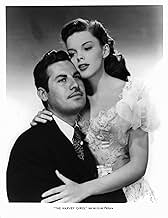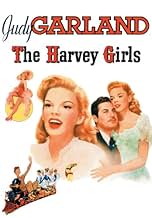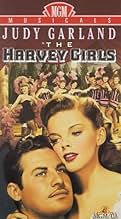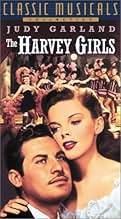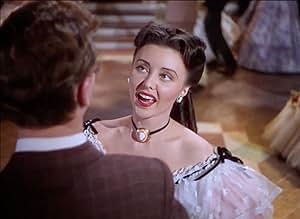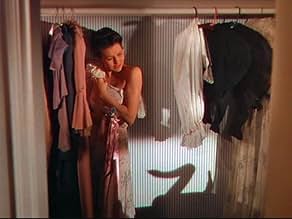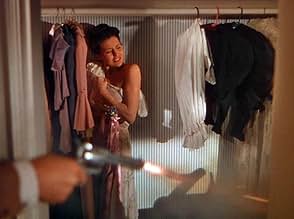NOTE IMDb
7,0/10
5,1 k
MA NOTE
Lors d'un voyage en train vers l'Ouest pour se marier à un homme qu'elle ne connaît pas, Susan Bradley rencontre une joyeuse équipe de jeunes femmes qui voyagent pour ouvrir un restaurant da... Tout lireLors d'un voyage en train vers l'Ouest pour se marier à un homme qu'elle ne connaît pas, Susan Bradley rencontre une joyeuse équipe de jeunes femmes qui voyagent pour ouvrir un restaurant dans une gare perdue.Lors d'un voyage en train vers l'Ouest pour se marier à un homme qu'elle ne connaît pas, Susan Bradley rencontre une joyeuse équipe de jeunes femmes qui voyagent pour ouvrir un restaurant dans une gare perdue.
- Réalisation
- Scénario
- Casting principal
- Récompensé par 1 Oscar
- 4 victoires et 1 nomination au total
William 'Bill' Phillips
- 1st Cowboy
- (as Wm. 'Bill' Phillips)
Avis à la une
As a lover of musicals and of Judy Garland, I watched The Harvey Girls and I really liked it on the whole. The plot though is cardboard especially in the second half and John Hodiak for my liking gives a rather lacklustre performance. Still it is worth seeing. The film with its beautiful costumes, scenery and photography does look gorgeous, the music is fantastic particularly the climatic set-piece On the Atchison, Topeka and The Santa Fe, the choreography is magnificent and the first half is great fun. The film is directed lovingly by George Sidney, and while Angela Lansbury and Ray Bolger are excellent, this is Judy Garland's film and she is absolutely wonderful. Overall, a lovely film. 8/10 Bethany Cox
The first person you see is Judy Garland singing an infinitely forgettable song.
For the most part it goes up from there.
This is a film that Vincente Minelly did not direct and even though it shows Judy at her demure best he had a knack for bringing out the best in her performances.
Surprisingly enough, this is not an entirely inaccurate history of the women that opened up the West -- just as much as the men did.
For those that do not know -- Fred Harvey was a railroad tycoon and visionary that realized that the United States could only expand Westward -- and he was there to help fulfill that dream.
His chain of "Railroad Hotels" (some of which still exist) and the women that staffed them, helped to civilize parts of the United States that were raw and uncultured.
This is one of those incredible films that has every face you have ever seen in a movie -- even if you do not always know their names: Ray Bolger, Preston Foster, Virginia O'Brien, John Hodiak, Angela Lansbury, Marjorie Main, Chill Wills and even Cyd Charisse.
This is cameo paradise and there is a character and face there for everyone.
The songs, the costumes, the sets and everything BUT the dialogue and story are top notch. But who needs a good script when you have a cast of STARS! (Especially Judy Garland.)
Take the good parts from this movie and try to pretend the rest never happened.
For the most part it goes up from there.
This is a film that Vincente Minelly did not direct and even though it shows Judy at her demure best he had a knack for bringing out the best in her performances.
Surprisingly enough, this is not an entirely inaccurate history of the women that opened up the West -- just as much as the men did.
For those that do not know -- Fred Harvey was a railroad tycoon and visionary that realized that the United States could only expand Westward -- and he was there to help fulfill that dream.
His chain of "Railroad Hotels" (some of which still exist) and the women that staffed them, helped to civilize parts of the United States that were raw and uncultured.
This is one of those incredible films that has every face you have ever seen in a movie -- even if you do not always know their names: Ray Bolger, Preston Foster, Virginia O'Brien, John Hodiak, Angela Lansbury, Marjorie Main, Chill Wills and even Cyd Charisse.
This is cameo paradise and there is a character and face there for everyone.
The songs, the costumes, the sets and everything BUT the dialogue and story are top notch. But who needs a good script when you have a cast of STARS! (Especially Judy Garland.)
Take the good parts from this movie and try to pretend the rest never happened.
"The Harvey Girls" is a splendid example of a well-crafted Metro-Goldwyn-Mayer musical from a time when well-crafted musicals were being dished out in abundance from Metro's golden bowl.
Inspired by the revolutionary success of "Oklahoma" on Broadway and tailored to fit the protean talents of it's young leading lady, Judy Garland, the film tells the story, in words and music, of a group of waitresses brought west in the late 1800's to open another link in the Fred Harvey chain of restaurants. In the process, they encounter all kinds of romantic and dramatic conflicts.
The cast is headed by Judy Garland, fresh from her triumph in the blockbuster musical "Meet Me In St. Louis" and her quietly moving dramatic performance in "The Clock". During the filming of "The Harvey Girls", Garland was one of the top box-office draws in the nation, and Hollywood's most versatile actress. She performs the role of Susan Bradley, an adventurous mail order bride who befriends the Harvey girls en route to New Mexico, with a vibrant comic touch. Her ability to combine tongue in cheek humor with her signature vulnerability is very satisfying in this film, and is an early highlight in her already legendary career.
The rest of the cast is first-rate: Angela Lansbury gives a wickedly fine performance as Em, the jaded dance-hall queen with hooded eyes and no-flies-on-me attitude. John Hodiak is the local tough guy and dance-hall owner, and also the object of Garland and Lansbury's affections. Broadway legend (and Garland's "Wizard of Oz" co-star) Ray Bolger does an amusing turn as the town's rubber legged blacksmith, and Preston Foster is the murderous Judge Purvis. The ranks of the Harvey girls are filled by some of Hollywood's most marvelous character actresses, including Marjorie Main and Virginia O'Brien, and the dancer Cyd Charisse in one of her first roles.
The film boasts what New York Times film critic Bosley Crowther appreciatively called "an abundance of chromatic spectacle and an uncommonly good score", the centerpiece of which is the Academy Award-winning song of the year (1946), "On The Atchison, Topeka, and the Santa Fe". This production number fills the screen with the colorful bustle of singers, dancers, and horses, and in the best Broadway tradition, advances the plot by introducing almost every cast member and giving them the opportunity to tell their story, in song, and their motivation for coming west in the first place. A spectacular bit of Golden Age musical magic, topped off by Garland's star turn entrance and full-throated belting of the Johnny Mercer/Harry Warren song.
The creative team behind this fable is as impressive as the talent in front of the camera. In addition to the score by Mercer and Warren, the film was directed by George Sidney ("Show Boat", "Annie Get Your Gun"), produced by Arthur Freed ("Singin In The Rain", "Gigi"), art directed by Cedric Gibbons ("The Great Zeigfeld", "The Wizard of Oz"), with musical direction by Lennie Hayton, orchestrations by Conrad Salinger, and musical arrangements by "Eloise" children's book author and singer Kay Thompson (a decade before she sizzled onscreen as the fashion magazine editor in the Audrey Hepburn classic "Funny Face").
This film will include restored Technicolor and stereo sound on DVD, and also a few musical numbers which were cut when the film was released due to length, and have been locked away in the MGM vaults. Now they have been restored, and the viewer can enjoy more of what film critic Howard Barnes called "a great big animated picture postcard."
Inspired by the revolutionary success of "Oklahoma" on Broadway and tailored to fit the protean talents of it's young leading lady, Judy Garland, the film tells the story, in words and music, of a group of waitresses brought west in the late 1800's to open another link in the Fred Harvey chain of restaurants. In the process, they encounter all kinds of romantic and dramatic conflicts.
The cast is headed by Judy Garland, fresh from her triumph in the blockbuster musical "Meet Me In St. Louis" and her quietly moving dramatic performance in "The Clock". During the filming of "The Harvey Girls", Garland was one of the top box-office draws in the nation, and Hollywood's most versatile actress. She performs the role of Susan Bradley, an adventurous mail order bride who befriends the Harvey girls en route to New Mexico, with a vibrant comic touch. Her ability to combine tongue in cheek humor with her signature vulnerability is very satisfying in this film, and is an early highlight in her already legendary career.
The rest of the cast is first-rate: Angela Lansbury gives a wickedly fine performance as Em, the jaded dance-hall queen with hooded eyes and no-flies-on-me attitude. John Hodiak is the local tough guy and dance-hall owner, and also the object of Garland and Lansbury's affections. Broadway legend (and Garland's "Wizard of Oz" co-star) Ray Bolger does an amusing turn as the town's rubber legged blacksmith, and Preston Foster is the murderous Judge Purvis. The ranks of the Harvey girls are filled by some of Hollywood's most marvelous character actresses, including Marjorie Main and Virginia O'Brien, and the dancer Cyd Charisse in one of her first roles.
The film boasts what New York Times film critic Bosley Crowther appreciatively called "an abundance of chromatic spectacle and an uncommonly good score", the centerpiece of which is the Academy Award-winning song of the year (1946), "On The Atchison, Topeka, and the Santa Fe". This production number fills the screen with the colorful bustle of singers, dancers, and horses, and in the best Broadway tradition, advances the plot by introducing almost every cast member and giving them the opportunity to tell their story, in song, and their motivation for coming west in the first place. A spectacular bit of Golden Age musical magic, topped off by Garland's star turn entrance and full-throated belting of the Johnny Mercer/Harry Warren song.
The creative team behind this fable is as impressive as the talent in front of the camera. In addition to the score by Mercer and Warren, the film was directed by George Sidney ("Show Boat", "Annie Get Your Gun"), produced by Arthur Freed ("Singin In The Rain", "Gigi"), art directed by Cedric Gibbons ("The Great Zeigfeld", "The Wizard of Oz"), with musical direction by Lennie Hayton, orchestrations by Conrad Salinger, and musical arrangements by "Eloise" children's book author and singer Kay Thompson (a decade before she sizzled onscreen as the fashion magazine editor in the Audrey Hepburn classic "Funny Face").
This film will include restored Technicolor and stereo sound on DVD, and also a few musical numbers which were cut when the film was released due to length, and have been locked away in the MGM vaults. Now they have been restored, and the viewer can enjoy more of what film critic Howard Barnes called "a great big animated picture postcard."
With Broadway still under the spell of musicals like "Oklahoma", MGM's Arthur Freed was inspired to make a western musical. Originally designed for Lana Turner, the script was altered and songs added to make it a perfect vehicle for Judy Garland. The songs by Johnny Mercer and Harry Warren included two standouts: "On the Atchison, Topeka and the Santa Fe" and "It's A Great Big World".
Judy gives an inspired performance and belts out her songs with gusto, particularly effective in the big set piece, "Atchison", which is photographed and choreographed with great precision to produce a dazzling show-stopping number. The film opened to great reviews and was a big box-office hit in the summer of '46.
Don't believe the "sour grapes" reviews claiming the film is dated and mediocre. It's anything but that. If you enjoy MGM musicals at the height of their popularity with film-goers, you'll enjoy this one! Marjorie Main is a treat, Selena Royle is dignified, Kenny Baker does wonders with a ballad and Cyd Charisse has a couple of nice numbers. It's nice to see Ray Bolger sharing scenes with Judy again, their first reunion since "Oz". The big surprise is Angela Lansbury as the garishly costumed dancehall hostess--a far cry from her "Murder She Wrote" image.
Understandably, "On the Atchison, Topeka and the Santa Fe" won the Academy Award for Best Song, as well as a nomination for Best Scoring of a dramatic or comedy film.
Judy gives an inspired performance and belts out her songs with gusto, particularly effective in the big set piece, "Atchison", which is photographed and choreographed with great precision to produce a dazzling show-stopping number. The film opened to great reviews and was a big box-office hit in the summer of '46.
Don't believe the "sour grapes" reviews claiming the film is dated and mediocre. It's anything but that. If you enjoy MGM musicals at the height of their popularity with film-goers, you'll enjoy this one! Marjorie Main is a treat, Selena Royle is dignified, Kenny Baker does wonders with a ballad and Cyd Charisse has a couple of nice numbers. It's nice to see Ray Bolger sharing scenes with Judy again, their first reunion since "Oz". The big surprise is Angela Lansbury as the garishly costumed dancehall hostess--a far cry from her "Murder She Wrote" image.
Understandably, "On the Atchison, Topeka and the Santa Fe" won the Academy Award for Best Song, as well as a nomination for Best Scoring of a dramatic or comedy film.
The Harvey Girls, a film to celebrate the first of the fast food chains which quite frankly would be what the Harvey Restaurant chain was back in the modernizing west. There are folks in the town who don't want to see the Harvey Restaurant established and thereby hangs the tale of this film.
Preston Foster is the town boss and John Hodiak runs the saloon. These guys thrive on the town being in the Wild West accent on the wild. Foster's a rather shrewd villain, he realizes that the clean cut virginal Harvey girls who are servers might make the men forget the loose women of the saloon and that if they court and marry them and start raising families, they might demand a little law and order. That would be a disaster for Foster. Better to cut the problem off at the root.
Hodiak however is a jaded sort and bored with the loose women of his establishment. In a cinema not under the Code influence, Angela Lansbury and her crew would be prostitutes. He kind of likes the idea of the Harvey Restaurant coming to town and likes it better when Judy Garland comes to town.
Judy's come to town as a mail order bride, but when she sees Chill Wills is the prospective groom, both of them decide they're not suited for each other. Hodiak has been writing Wills's letters, a plot device that was used in the Joseph Cotten-Jennifer Jones film Love Letters. If you know about that film, you know how The Harvey Girls turns out.
The Harvey Girls has come down in cinema history because of the famous On The Atchison, Topeka, And The Santa Fe number. The song itself won an Academy Award in 1946 for best original song and the number as staged by MGM is one of the longest and most complex in the annals of film. It runs about 20 minutes and just about every member of the cast except Hodiak and Foster get a line or two in the song. Of course it ends with Judy as well it should have.
One thing I don't understand though is the under use of both Ray Bolger and Kenny Baker. Bolger of course had co-starred with Judy in The Wizard Of Oz, but he was far more known for being a Broadway star than a film player. He had just come off a big run in the last Rodgers&Hart musical By Jupiter. Kenny Baker was a famous radio singer who also had starred on Broadway in Kurt Weill's One Touch Of Venus with Mary Martin. Why these guys got the supporting roles they did is a mystery to me. I suspect both of them had a lot of their parts end up on the cutting room floor.
MGM editing mastery was at its best in The Harvey Girls. The film was partially done on location and partially done at Culver City. The editing is so smooth you really can't tell.
Harry Warren and Johnny Mercer wrote the score for The Harvey Girls and while the Atchison number dwarfs the rest, there's a song called It's A Great Big World that gets sadly neglected. It was sung by Judy Garland, Virginia O'Brien, and someone dubbing Cyd Charisse who first got noticed in this film for her dancing.
As I said before if done today if some gazillionaire would finance a remake, Angela and her saloon girls would be portrayed more frankly as working girls. But that would also cause the film to lose some of its naive charm. And this film holds up quite well for 63 years and counting.
Preston Foster is the town boss and John Hodiak runs the saloon. These guys thrive on the town being in the Wild West accent on the wild. Foster's a rather shrewd villain, he realizes that the clean cut virginal Harvey girls who are servers might make the men forget the loose women of the saloon and that if they court and marry them and start raising families, they might demand a little law and order. That would be a disaster for Foster. Better to cut the problem off at the root.
Hodiak however is a jaded sort and bored with the loose women of his establishment. In a cinema not under the Code influence, Angela Lansbury and her crew would be prostitutes. He kind of likes the idea of the Harvey Restaurant coming to town and likes it better when Judy Garland comes to town.
Judy's come to town as a mail order bride, but when she sees Chill Wills is the prospective groom, both of them decide they're not suited for each other. Hodiak has been writing Wills's letters, a plot device that was used in the Joseph Cotten-Jennifer Jones film Love Letters. If you know about that film, you know how The Harvey Girls turns out.
The Harvey Girls has come down in cinema history because of the famous On The Atchison, Topeka, And The Santa Fe number. The song itself won an Academy Award in 1946 for best original song and the number as staged by MGM is one of the longest and most complex in the annals of film. It runs about 20 minutes and just about every member of the cast except Hodiak and Foster get a line or two in the song. Of course it ends with Judy as well it should have.
One thing I don't understand though is the under use of both Ray Bolger and Kenny Baker. Bolger of course had co-starred with Judy in The Wizard Of Oz, but he was far more known for being a Broadway star than a film player. He had just come off a big run in the last Rodgers&Hart musical By Jupiter. Kenny Baker was a famous radio singer who also had starred on Broadway in Kurt Weill's One Touch Of Venus with Mary Martin. Why these guys got the supporting roles they did is a mystery to me. I suspect both of them had a lot of their parts end up on the cutting room floor.
MGM editing mastery was at its best in The Harvey Girls. The film was partially done on location and partially done at Culver City. The editing is so smooth you really can't tell.
Harry Warren and Johnny Mercer wrote the score for The Harvey Girls and while the Atchison number dwarfs the rest, there's a song called It's A Great Big World that gets sadly neglected. It was sung by Judy Garland, Virginia O'Brien, and someone dubbing Cyd Charisse who first got noticed in this film for her dancing.
As I said before if done today if some gazillionaire would finance a remake, Angela and her saloon girls would be portrayed more frankly as working girls. But that would also cause the film to lose some of its naive charm. And this film holds up quite well for 63 years and counting.
Le saviez-vous
- AnecdotesIn the big production number "On the Atchison, Topeka and the Santa Fe," from Judy Garland's entrance until the conductor's "All aboard!" was done in one take. Legend has it that they shot it twice and Garland was dead-on move for move both times.
- GaffesIn the "Wild, Wild West" song, Alma is pounding a red-hot horseshoe. She then picks it up, caresses it, and throws it in the water barrel where it gives off steam. The horseshoe would have burned her hand if it were really hot. This is a sight gag in the film.
- ConnexionsFeatured in MGM Parade: Épisode #1.25 (1955)
- Bandes originalesIn the Valley (Where the Evenin' Sun Goes Down)
(uncredited)
Music by Harry Warren
Lyrics by Johnny Mercer
Performed by Judy Garland
Meilleurs choix
Connectez-vous pour évaluer et suivre la liste de favoris afin de recevoir des recommandations personnalisées
Everything New on HBO Max in June
Everything New on HBO Max in June
Looking for something different to add to your Watchlist? Take a peek at what movies and TV shows are coming to HBO Max this month.
Détails
Box-office
- Budget
- 2 524 315 $US (estimé)
- Montant brut mondial
- 1 417 $US
- Durée1 heure 42 minutes
- Rapport de forme
- 1.37 : 1
Contribuer à cette page
Suggérer une modification ou ajouter du contenu manquant

Lacune principale
By what name was Les demoiselles Harvey (1946) officially released in India in English?
Répondre

